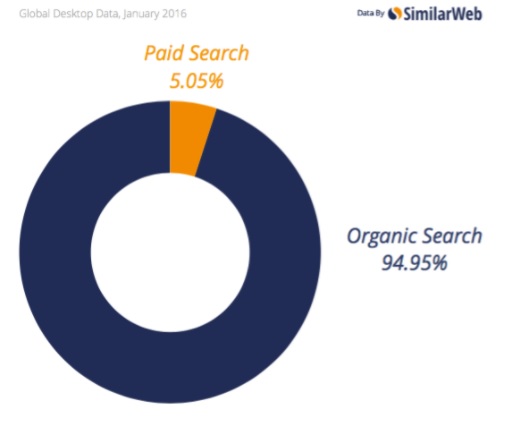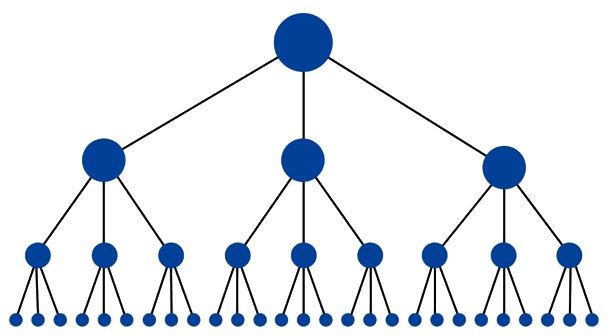Improve Your Business Rankings in Just 5 Steps
Three little letters that have a big impact on whether people can find you online: SEO. Search Engine Optimization is a critical tactic needed to ensure that people are finding you online. Imagine creating a beautiful business brochure — that sits in a closet and never sees the light of day. If it doesn’t make it into the hands of your potential customers, it doesn’t help you. The same is true if your website can’t be found by people searching online.
How do you make sure your website is found?
Search Engine Optimization (SEO) ensures that your business is found and ranked by search engines like Google, Yahoo, and Bing. Rankings matter because research shows that people rarely even go beyond the first search engine results page (SERP). In fact, 60% of clicks go to the top three websites in SERPs.
Think pay-to-play will make up for low organic rankings? Think again. There’s no question that competitive bids on Adwords will give you high placement, but paid search only accounts for roughly 5% of clicks.

Where do you start with SEO?
SEO tactics are as numerous as they are complex — because so are the search engine algorithms they are helping you to decode. It’s important to seek out guidance from experts who really know what they’re doing, especially in highly competitive markets. But even businesses with a small budget can get started on their own.
Here’s a quick guide to improve your business rankings in 5 steps:
1. Use Keywords Strategically.
Your SEO Keywords are the words built into your site that enable people to find you when they search online. Keywords can be single words or phrases that people enter into search engines. In order to make sure your business is being found, you must make sure to incorporate relevant keywords into your site. This is done by using the right keywords in your site structure, navigation menu, URLs, meta tags, titles, page descriptions, and on-page content, to name a few.
Example: If you own a boutique shoe store, you’ll want to use some obvious keywords related to shoes on your website. Imagine if you only used keywords related to specific styles: pumps, stilettos, sneakers — instead of also using the obvious word “shoe”. You could have an entire website about shoes without the word “shoe” and Google would not know that your site is relevant when people search “local shoe stores”.
Pro Tip: Use a free keyword research tool, such as Google Keyword Planner, to select relevant keywords based on search volume and competition. If your website is built on WordPress, we also recommend using a tool like Yoast SEO to help you easily build out your meta tags, descriptions, and Titles.
2. Focus on On-Site Optimization.
Content changes made directly on your website to help it rank higher on search engines. Optimization is done by including relevant keywords and long-tail keywords on your site.
Title Tags: Each web page needs a title tag with keywords relevant to the content on that page.
Header Tags: Multiple levels of heading tags are a critical component on all pages. They should be listed in order of importance.
Alt Tags: All images must include an alternative image description using relevant topics and keywords.
Internal Links: Linking to pages and blog posts within your website will help build authority.
Navigation Menu: Use relevant keywords in your navigation menu and be sure to build the menu in an order of importance recognized by search engines.
URLs: Make sure to use relevant keywords in blog post and page URLs.
3. Generate Quality Content to Optimize.
Writing timely, relevant content not only establishes you as a thought leader in your industry, it also provides you with places to use your keywords to add to your optimization. According to Andrey Lipattsev, Search Quality Senior Strategist at Google, high quality content and link building are the two most important signals used by Google to rank your website for search.
Making the case for long-form content: A Backlinko report revealed that longer content tends to rank higher. The average first page result on Google contains 1,890 words. At the very minimum, you want to aim for 500 words. Stronger content will range from 800 to 1,000 words. A July 2015 study by Moz and BuzzSumo analyzed the shares and links of over 1 million articles and found that long form content of over 1,000 words consistently receives more shares and links than shorter form content.
Don’t forget that when optimized correctly, images are content too. The Backlinko study also reported that using a single image within content will increase search engine rankings.
Pro Tip: Updating and republishing old blog posts with new content and images can increase organic traffic by as much as 111%. (Backlinko)
4. Build Your Links.
When determining ranking authority, search engines look at a multitude of factors. Two critical components are your internal and external links.
Internal Linking Structure: Internal allow people to navigate a website by linking from one page on a domain to a different page on the same domain. In addition to helping users navigate your site, internal links are also important for establishing site architecture and ranking power around websites. Moz details SEO best practices for internal links by explaining site structure and how internal links “talk” to search engines through spiders. For beginners, it is simply important to know how your website structure plays a role in rankings, so that you are properly including internal links. The optimal structure for a website should look like a pyramid, where the large dot at the top is your homepage.

External Links & Backlink Building: Relevant links to your site from other websites can help build your website’s authority, and in turn help improve your search engine rankings. Connect with other industry leaders to include backlinks on blogs, webpages, or online directories. Sites that are .edu or news domains are particularly strong sites to help build authority.
5. Keep Online Directories Consistent.
Consistency is key in online directory listings. Make sure that your name, address, and phone number (NAP) are the same across all platforms, as this is directly tied to Google’s local ranking algorithm. These directories include Google Places, Yelp, Bing, and others connected to your business.



